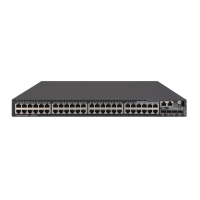141
Disabling an interface from sending/receiving IS-IS packets
After being disabled from sending and receiving hello packets, an interface cannot form any
neighbor relationship, but can advertise directly connected networks in LSPs through other
interfaces. This can save bandwidth and CPU resources, and ensures that other routers know
networks directly connected to the interface.
To disable an interface from sending and receiving IS-IS packets:
Step Command Remarks
1. Enter system view.
system-view
N/A
2. Enter interface view.
interface
interface-type
interface-number
N/A
3. Disable the interface from
sending and receiving IS-IS
packets.
isis silent
By default, the interface can send
and receive IS-IS packets.
Enabling an interface to send small hello packets
IS-IS messages cannot be fragmented at the IP layer because they are directly encapsulated in
frames. Any two IS-IS neighboring routers must negotiate a common MTU. To avoid sending big
hellos to save bandwidth, enable the interface to send small hello packets without CLVs.
To enable an interface to send small hello packets:
Step Command Remarks
1. Enter system view.
system-view
N/A
2. Enter interface view.
interface
interface-type
interface-number
N/A
3. Enable the interface to send
small hello packets without
CLVs.
isis small-hello
By default, the interface can send
standard hello packets.
Configuring LSP parameters
Configuring LSP timers
1. Specify the maximum age of LSPs.
Each LSP has an age that decreases in the LSDB. Any LSP with an age of 0 is deleted from the
LSDB. You can adjust the age value based on the scale of a network.
To specify the maximum age of LSPs:
Step Command Remarks
1. Enter system view.
system-view
N/A
2. Enter IS-IS view.
isis
[ process-id ] [
vpn-instance
vpn-instance-name ]
N/A
3. Specify the maximum LSP
age.
timer lsp-max-age
seconds
The default setting is 1200
seconds.
2. Specify the LSP refresh interval and generation interval.

